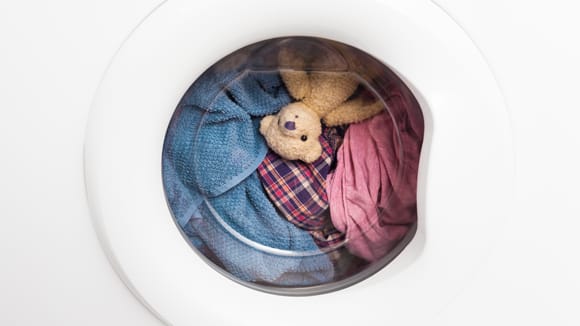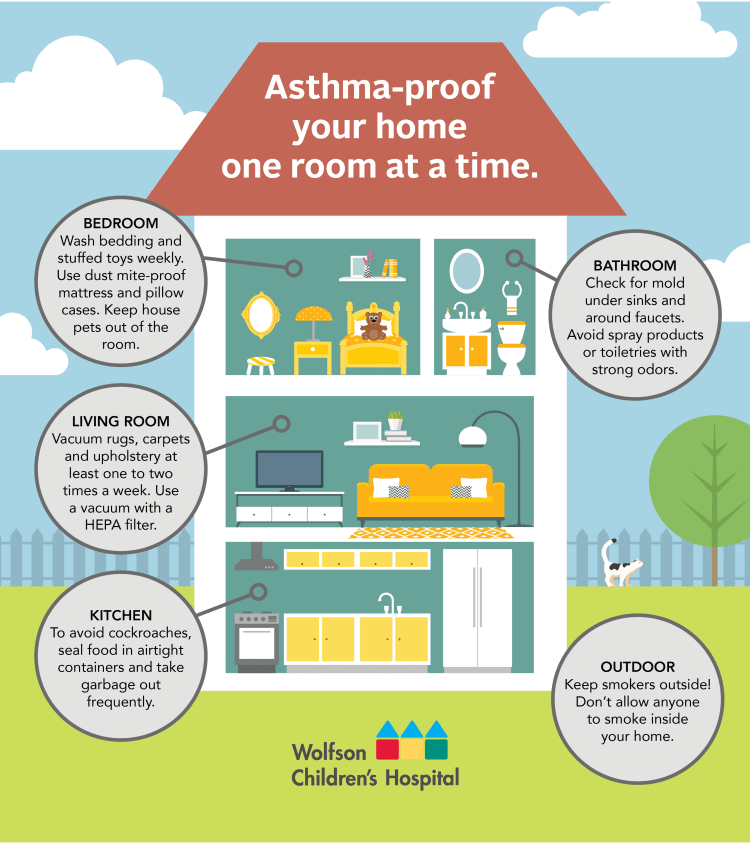Asthma-proof your home
Tips to reduce possible asthma triggers for kids.
Article Date:

Asthma is a chronic disease that causes the airways to become irritated and inflamed. Symptoms include coughing, wheezing, difficulty breathing and chest pain. It can be intermittent, or it can interfere with daily life.
Asthma is the No. 1 reason children miss school. In some cases, asthma can even lead to a life-threatening attack.
Asthma management starts at home
Carey Smith, RRT, asthma educator with THE PLAYERS Center for Child Health at Wolfson Children's Hospital, teaches families of hospitalized patients with asthma that proper management of the condition starts at home. Taking a few precautions in each room of the house can drastically reduce the number of possible asthma triggers for kids.
1. Living room
The main culprit for triggering asthma in the living area is fabric: rugs, carpets and cloth-covered furniture all have fibers that trap irritants such as dust mites. These microscopic insects then feed on dead human skin, both of which work their way into furniture and fabrics around the house. That's where these bugs usually take up residence.
The mites' waste and body parts are allergens for many people, and carpet unfortunately holds onto dust mites as well as pet dander and other irritants. In a home with carpet, it's important to use a high-efficiency particulate air (HEPA) vacuum at least one to two times a week.
"Using a HEPA vacuum helps prevent allergens from escaping into the air," Smith said. "Or, if possible, get rid of wall-to-wall carpeting and use hardwood floors."
Vacuuming stirs up irritants, so during cleanup, have children with asthma play outside, visit a friend's house or at least stay out of the recently vacuumed room for a few hours.
2. Kitchen
Proper food storage is essential for many reasons, but if a child with asthma lives in the home, it takes on a whole new importance. Cockroaches and mice are attracted to trash cans and improperly stored food.
"Cockroaches and mice are mostly nocturnal, scavenging at night for food and water, and leaving behind trails of allergens that cause symptoms on contact or when inhaled. Cockroach allergens are believed to be feces, saliva and body parts. Mice allergens are skin, saliva and urine," said Smith.
Cockroach feces become a white residue powder that when inhaled, can cause inflammation. Smith recommends not leaving food out and keeping trash cans sealed with heavy lids to reduce pests. If roaches do creep in, avoid aerosol bug sprays to kill pests indoors and stick to gel repellants or poison baits instead.
3. Bathroom
Mold isn't good for anyone, but it can be especially dangerous for those with asthma. The American College of Occupational and Environmental Medicine estimates that about 10% of people have a mold allergy, with 5% showing symptoms.
"Mold is all around us. It's in the places we live, work, and play – both inside and outside. Anywhere you find moisture and oxygen, you may find mold. There are 100,000 different types," Smith said.
The Community Asthma Partnership at Wolfson Children's Hospital recommends fixing leaky pipes immediately and cleaning moldy surfaces with a bleach-based product.
Check under sinks and around the faucets for black or green mold. If there is a mold problem, make sure children are not present when cleaning, as the airborne spores can cause an asthma flare-up.
When using scented hair products, toiletries or perfumes, avoid strong odors and sprays. The pungent smells can irritate a child's asthma even hours after use. Be especially careful if the child is in the room during usage.
Smith also shared that scented cleaning products, air fresheners and candles can also irritate a child's airways. Avoid using these, especially when children are in the room.
4. Bedroom
A child's bedroom is where they spend anywhere from eight to 13 hours a day, and that's only while sleeping. It may be even more if they spend time in there playing or doing homework. Because of this, their bedroom may be one of the most important rooms to make asthma-friendly.
"Has it been a while since you've cleaned your child's bedding? Start there. One of the most effective ways to keep dust mites from building up on a child's sheets, pillowcases, blankets and comforter is by washing them weekly in hot (130 degrees F) water, notes the American Academy of Allergy, Asthma & Immunology (AAAAI). The hot water will kill off the dust mites," Smith said.
As for the pillows and mattress, dust mite-proof covers help will keep these tiny creatures from moving in and causing irritation during the night.
"Don't forget to dust and vacuum regularly, too, to avoid buildup of dust and other triggers," said Smith.
And when it comes to pets, keep Fido and Fluffy out of the bedroom. A dog, cat or any animal with a lot of dander will worsen asthma.
"Restrict pets to one area of the home when inside, and always wash your hands after playing with your four-legged loved ones," Smith said.

Interested in more resources to reduce your child's asthma attacks?
The Community Asthma Partnership (CAP-W) at Wolfson Children's Hospital offers free educational programs and digital resources to support the health of your child.



